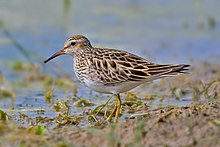Pectoral sandpiper
| Pectoral sandpiper | |
|---|---|

| |
| Adult in breeding plumage | |
| Scientific classification | |
| Domain: | Eukaryota |
| Kingdom: | Animalia |
| Phylum: | Chordata |
| Class: | Aves |
| Order: | Charadriiformes |
| Family: | Scolopacidae |
| Genus: | Calidris |
| Species: | C. melanotos
|
| Binomial name | |
| Calidris melanotos (Vieillot, 1819)
| |

| |
| Synonyms | |
|
Actodromas maculata | |
The pectoral sandpiper (Calidris melanotos) is a small,
Taxonomy
The pectoral sandpiper is sometimes separated with the "
"Cox's sandpiper" ("Calidris" × paramelanotos) is a stereotyped hybrid between this species and the curlew sandpiper. This does not prove a particularly close relationship between these two species, as far more distantly related waders have successfully hybridized. In any case, among the stint clade the red-necked stint ("C." ruficollis) and the long-toed stint ("C." subminuta) are particularly close relatives of the pectoral sandpiper.[2]
The scientific name is from Ancient Greek. The genus name kalidris or skalidris, is a term used by Aristotle for some gray-colored waterside birds. The specific melanotos is from melas, "black" and notos, "backed ".[3]
Description

This bird looks similar to the widely
The juveniles are more brightly patterned above with rufous coloration and white mantle stripes.
This species differs from the sharp-tailed sandpiper in its breast pattern, weaker supercilium and grayer crown.
| Standard Measurements[5][6] | |
|---|---|
| length | 200–240 mm (8–9.6 in) |
| weight | 73 g (2.6 oz) |
| wingspan | 460 mm (18 in) |
| wing | 136–142.8 mm (5.35–5.62 in) |
| tail | 60.4–63.9 mm (2.38–2.52 in) |
| culmen | 28.7–29.3 mm (1.13–1.15 in) |
| tarsus | 27.8–30 mm (1.09–1.18 in) |
Distribution and ecology

It is a very long-distance
This species also occurs as a regular migrant to western
The pectoral sandpiper's migration might be affected by
These birds forage on grasslands and mudflats, picking up food by sight, sometimes by probing. They mainly eat
The male has a courtship display which involves puffing up his breast, which has a fat sac in the breeding season to enhance his performance.The pectoral sandpiper builds a steep-sided
Pectoral sandpipers have decreased in number 50% since 1974.[19]
References
- . Retrieved 13 November 2021.
- ISBN 978-1-4081-2501-4.
- ^ Robinson, R.A. (16 July 2010). "Pectoral Sandpiper Calidris melanotos". BirdFacts: profiles of birds occurring in Britain & Ireland (BTO Research Report 407). Thetford: bto.org. Retrieved 9 August 2012.
- ^ Godfrey, W. Earl (1966). The Birds of Canada. Ottawa: National Museum of Canada. p. 152.
- ISBN 0-679-45122-6.
- ^ "TAXON: Pectoral Sandpiper, Calidris melanotos". U.S. Geological Survey. Retrieved 9 August 2012.
- ISBN 0-9507881-2-0. Archived from the original on 23 January 2009.)
{{cite book}}: CS1 maint: unfit URL (link - ISBN 1-900455-18-8.
- ^ Lees, A.C.; Gilroy, J.G. (2004). "Pectoral Sandpipers in Europe: vagrancy patterns and the influx of 2003". British Birds. 97 (12): 638–646.
- JSTOR 1362896.
- ^ Wiles, Gary J.; Johnson, Nathan C.; de Cruz, Justine B.; Dutson, Guy; Camacho, Vicente A.; Kepler, Angela Kay; Vice, Daniel S.; Garrett, Kimball L.; Kessler, Curt C.; Pratt, H. Douglas (2004). "New and Noteworthy Bird Records for Micronesia, 1986–2003". Micronesica. 37 (1): 69–96.
- ^ VanderWerf, Eric A. (2006). "Observations on the birds of Kwajalein Atoll, including six new species records for the Marshall Islands". Micronesica. 38 (2): 221–237.
- ^ VanderWerf, Eric A.; Wiles, Gary J.; Marshall, Ann P.; Knecht, Melia (2006). "Observations of migrants and other birds in Palau, April–May 2005, including the first Micronesian record of a Richard's Pipit". Micronesica. 39 (1): 11–29.
- Wilson Bulletin. 18 (2): 47–60.
- ^ "Annotated Ohio state checklist" (PDF). Ohio Ornithological Society. 2004. Archived from the original (PDF) on 18 July 2004.
- ^ a b https://sta.uwi.edu/fst/lifesciences/sites/default/files/lifesciences/images/Calidris_melanotos%20-%20Pectoral%20Sandpiper.pdf [bare URL PDF]
- .
- ISSN 0362-4331. Retrieved 2018-04-27.
Further reading
- Hayman, Peter; Marchant, John; Prater, Tony (1986). Shorebirds: an identification guide to the waders of the world. Boston: Houghton Mifflin. ISBN 0-395-60237-8.
External links
- BirdLife species factsheet for Calidris melanotos
- "Calidris melanotos". Avibase.
- "Pectoral sandpiper media". Internet Bird Collection.
- Pectoral sandpiper photo gallery at VIREO (Drexel University)
- Interactive range map of Calidris melanotos at IUCN Red List maps
- Audio recordings of Pectoral sandpiper on Xeno-canto.
- Calidris melanotos in Field Guide: Birds of the World on Flickr
- Pectoral sandpiper media from ARKive

